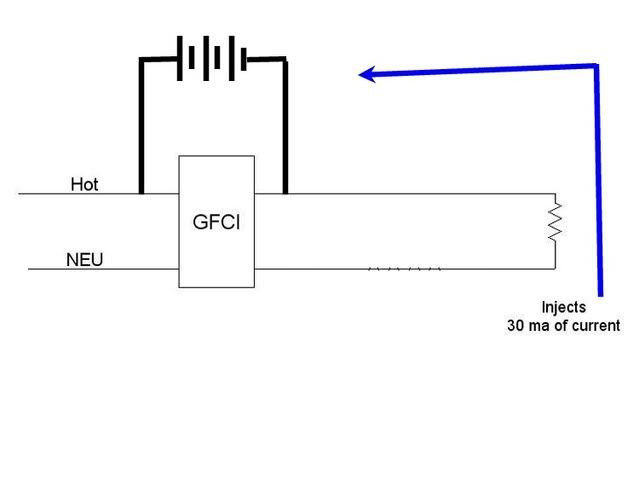crossman
Senior Member
- Location
- Southeast Texas
crossman said:Yours won't. But I think mine will:

480sparky said:Change the battery to a resistor. Same result.
crossman said:Yours won't. But I think mine will:

weressl said:Yep, it sure shorts out the battery
crossman said:No problem shorting out the battery. As indicated by the level of current flow, it has an internal resistance that limits the current flow.
But does it trip the GFCI?
weressl said:Indicated where? By what?
weressl said:Laptop batteries may have integral regulators, but ordinary battery short circuited sure spells disaster.
weressl said:DC current will not activate an AC current sensor as a normal course of design. There would be no reason to design it that way.
crossman said:The lower right hand portion of the diagram.
I am shorting out a AA battery right now as I am typing this. No disaster has occurred. I am alive and well. It did not even burn my fingers.
Would there be a reason not to design it that way? I imagine that the designers never even considered what is happening and the diagram, so I doubt they would intentionally design the circuit to avoid tripping with the battery applied.
I still bet that it will trip. I may be wrong. But I am still going with "trip".
Edit: removed extraneous quote
roger said:. . . but the truth is, under a 590 application and an assured grounding program in place, GFCI's are not necessary because in the event of a ground fault most of the current will be shunted around the user.
Let me offer the possibility that a person might come into contact with an energized portion of a piece of equipment, without there being any contact between that same energized portion and the external metal parts to which the EGC is connected. I know, the case is supposed to be on the outside, and you are not supposed to open the case to reach inside. But it can happen; it has happened.don_resqcapt19 said:With a correctly installed and functioning EGC, there should not be a hazardous voltage and if there is, there will be enough current flowing to get into the instantaneous trip range of the breaker so the hazard will not exist for long.
gar said:080722-0944 EST
I concur with crossman that the AC induced current from the current transformer in the neutral output line will not trip the GFCI because it does not produce an unbalanced current between hot and neutral.
.
charlie b said:Let me offer the possibility that a person might come into contact with an energized portion of a piece of equipment, without there being any contact between that same energized portion and the external metal parts to which the EGC is connected. I know, the case is supposed to be on the outside, and you are not supposed to open the case to reach inside. But it can happen; it has happened.
I changed my views of the nature of fault current and the hazards of commonplace electrical stuff about five or six years ago, when I read a short article from a Chicago area newspaper. I have added this story to the training class that I had developed on the topic of electrical theory. I have also gone on a minor campaign to teach people the importance of installing GFCI protections for all receptacle outlets outdoors (even if the grandfather rule would not require them in your house).
A woman was electrocuted while operating a weed cutting tool in her yard. The grass was wet, and the extension cord had been damaged. The fatal current path was from the breaker panel to the hot pin of the receptacle, through the ungrounded conductor of the extension cord, to the water that had entered through the break in the cord?s insulation, through water or dirt that had accumulated along the outside of the cord, into her hands, through her body, into the dirt beneath her feet, through planet Earth to the ground rod, up the GEC to the service panel, via the N-G bond point back to the service?s grounded conductor. The external case of the tool may or may not have been metal, and the cord may or may not have included a EGC. It would not have mattered. A GFCI would have saved her life, but an EGC would not have.
crossman said:No problem shorting out the battery. As indicated by the level of current flow, it has an internal resistance that limits the current flow.
But does it trip the GFCI?
480sparky said:if the current flow through the battery exceeds the trip rating of the GFI, then it will trip.
It shouldn't.ELA said:Would this trip a GFCI?

You are correct. You can't "inject" current into the circuit because you would violate Kirchoff's Current Law. The conductor is not a hose, even though some water analogies work fine for some limited cases.LarryFine said:It shouldn't.
